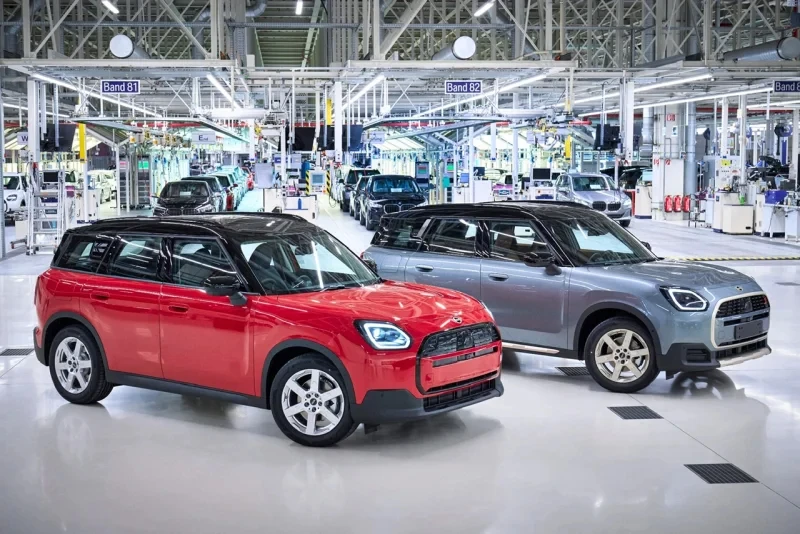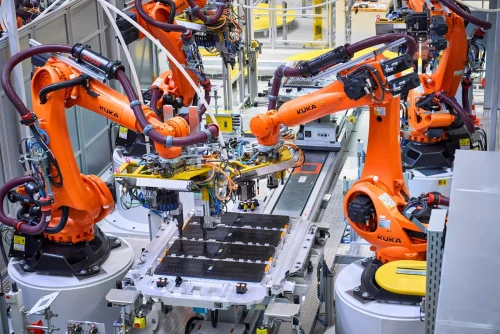The all-electric version of the MINI Countryman is now rolling off the lines at BMW Group Plant Leipzig, four months after the production launch of the combustion-engined MINI Countryman.
After phasing out production of the BMW i3, the birthplace of electric mobility at the BMW Group now manufactures four models with three drive types by two brands, all on a single production line: the BMW 1 Series, the BMW 2 Series Active Tourer (including the plug-in hybrid version), the BMW 2 Series Gran Coupe and the MINI Countryman in both its fully electric and combustion-powered versions.

The MINI Countryman Electric represents a major step in the MINI brand’s transition to full electrification by 2030 and combines an electrified go-kart feel with zero local emissions mobility. It comes in two fully electric variants: the Countryman E (150 kW, 204 hp | electricity consumption 17.4 – 15.7 kWh/100 km) and the more powerful all-wheel Countryman SE ALL4 (230 kW, 313 hp | electricity consumption 18.5 – 16.8 kWh/100 km).
To enable production of up to 350,000 units a year—100,000 more than previously—Plant Leipzig has been continuously upgraded since 2018, with extensive additions and upgrades to the bodyshop, paintshop, assembly and logistics.
In recent years the BMW Group has invested around 1.6 billion euros in the Leipzig site to produce additional vehicles and electric components, and now we’re increasing vehicle volumes too, which is great news for our plant.
—Petra Peterhänsel, Plant Director
The main driver behind the volume increase is the MINI Countryman. During the course of 2024, output will rise to almost 500 units a day, on top of the 800 or so BMW vehicles the plant is producing. With its flexible production system, Plant Leipzig is in a position to respond quickly to customer demand—for example by increasing the share of fully electric vehicles.
Flexible assembly structures also meant the MINI Countryman Electric could be integrated seamlessly into production. The situation is similar with the different drive units, which are all produced on one and the same line in aggregate assembly and prepared for marriage with the body.
The e-drives, transmissions and control electronics (collectively known as the highly integrated electric drive topology, or HEAT) for the two all-electric models are connected directly in the plant. A new production line was required only for the control electronics.
By the end of 2024, Plant Leipzig will employ around 7,000 BMW staff. Working hours will need to be adjusted in all technologies, with nightshifts in assembly starting for the first time in September of this year and cars being produced round the clock in three shifts.
With the production launch of the MINI Countryman Electric, all three stages of the Gen 5 high-voltage battery production process are now represented at BMW Group Plant Leipzig: cell coating, module production and battery assembly. Operations in all three are currently ramping up, with five cell-coating, three module-production and two high-voltage battery-production lines now in place.

We are in the middle of the transformation to e-mobility. Starting this year, Plant Leipzig will carry out every stage of our in-house high-voltage battery production process. It’s our next great step forwards.
—Markus Fallböhmer, Head of Battery Production at the BMW Group
Plant Leipzig’s e-component production capacity has been increasing since 2021. It will now manufacture not just the high-voltage batteries for the MINI Countryman Electric but also e-components for the BMW iX1, BMW iX2, BMW i4, BMW i5 and BMW iX made at other sites. The e-component production unit at Leipzig currently employs some 1,000 people.
To enable production of high-voltage batteries, spaces previously used for the BMW i3 and BMW i8 have been converted and new buildings added. One of them is a new hall with a footprint of about 61,000 m2. This houses two lines capable of producing up to 300,000 high-voltage batteries a year. The BMW Group has invested more than €900 million in e-component production at Plant Leipzig to date.
Resource-saving painting processes. At launch, the fully electric MINI Countryman comes in three additional body colors: British Racing Green, Chili Red and Blazing Blue—and with MINI’s trademark contrast roof, if desired. This is painted using a new overspray-free method that saves resources and is currently being readied for series operation.
The term “overspray” refers to the mist of excess paint particles that forms when bodies are painted the conventional way. With the new technique, this mist no longer occurs. This makes it easier to paint in multiple colors as the laborious process of masking is no longer required. Overspray-free painting also helps save CO2 emissions, as exhaust from the cabin requires less cleansing. In addition, it requires considerably less conditioned air—i.e. air that is brought to the exact temperature and humidity required for painting. As a result, less energy is needed to temper air and treat exhaust.
The burner technology used to dry the paint on contrast roofs was also converted for the start of MINI Countryman production and now consists of a bivalent system. The fuel-flexible burners can run on hydrogen as well as gas (methane) and even switch between the two while in operation. Five such bivalent hydrogen-capable burners are used to produce the contrast roofs for the MINI Countryman.
Further burners in the paintshop will also gradually switch to bivalent operations, with the next six hydrogen-capable burners just installed. This makes Leipzig a pioneer in the automotive industry and takes it ever closer to lower CO2 emissions.
Our vision at Plant Leipzig is to decarbonise production as far as possible by replacing fossil fuels with green hydrogen.
—Petra Peterhänsel
This will require sufficient green hydrogen from a grid. A regional hydrogen grid is currently in planning, with Plant Leipzig set to benefit.
Source from Green Car Congress
Disclaimer: The information set forth above is provided by greencarcongress.com independently of Chovm.com. Chovm.com makes no representation and warranties as to the quality and reliability of the seller and products.




